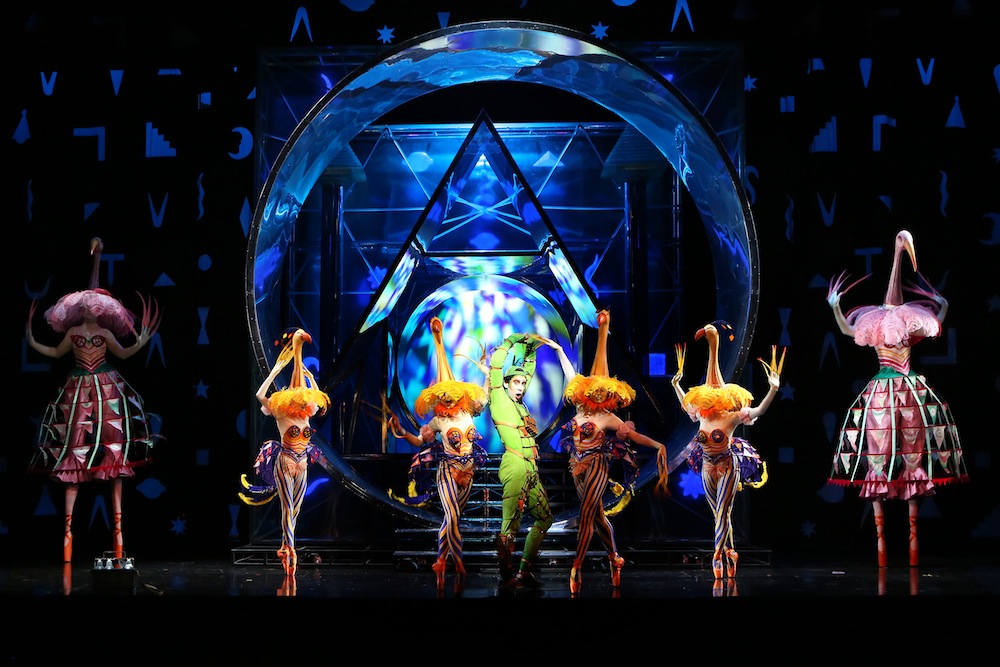★★★★½ There’s still plenty of life left in Julie Taymor’s tried and tested production of Mozart’s Masonic masterpiece.
Joan Sutherland Theatre, The Sydney Opera House
December 30, 2015
Mozart’s The Magic Flute is one of those operas you can see a hundred times and still find something fresh in it. Perhaps that owes to the genius of the music, or the universality of its themes: courage, virtue and honesty. Whatever it is, Opera Australia’s version, a reproduction of Julie Taymor’s Met staging, with its myriad symbols and pyramids, animals and priests, colours and movement, is a musical and visual extravaganza.
One of the goals of this particular production is the democratisation of music; as such, the direction, the staging and the brisk edited version of this production is perfectly suited for newcomers to opera. This is a noble idea, and very much in keeping with what Mozart was trying to achieve when he collaborated with Schikaneder on this Singspiel, incorporating both singing and spoken dialouge. In Mozart’s own words to his wife, “What really makes me happy is the Silent applause!—one can feel how this opera is rising and rising.” He really meant to draw in all comers, and tickets for the opening production in 1791 (just a few months before his death) were very cheap by the standards of the day.
All this said, and call me a purist, but the decision to omit the overture was unfortunate: not only is it one of the great operatic curtain raisers, but without the all important C minor second chord (the relative minor of E-flat major, the opera’s home key), it is very hard to convey the contrast between night and day – and by extension good and evil – that is at the core of this opera, and the Enlightenment itself. When the Queen of the Night instructs her daughter to kill the good King Sarastro, without establishing that opening major-minor conflict, the opera feels a little empty.
This quibble aside, the performance was impressive. Kudos to Director Matthew Barclay and Set Designer George Tsypin: the staging was clearly challenging, but it fit seamlessly with the action, both thematically and technically. The brilliant oranges of Sarastro’s temple of wisdom and light contrasted well with the darker hues associated with the evil Queen of the Night. The choreography was also highly entertaining, such as when Sorastro turns his henchmen on poor old Monostatos, only for Papageno’s transfixing bells to diffuse the situation, turning the scene into a camp dance party, whips, pelvis thrusts and all!
 Samuel Dundas as Papageno
Samuel Dundas as Papageno
Speaking of Papageno, Samuel Dundas really stole the show as the goofy, humble bird catcher. He acted well, bounded around the various contraptions on stage, and sang with amazing versatility: he was sensitive when he pined for a female companion, despairing when he contemplated suicide, and jolly when absorbed by the simple pleasures of food and wine.
John Longmuir as Tamino and Taryn Fiebig as Pamina were the other standouts. Their love came across sincerely, with Fiebig very moving in her anguish for the mute Tamino who had vowed an oath of silence to win her love. Longmuir was solid throughout, with a sound that was unforced and penetrating. Daniel Sumegi’s Sarastro warmed to the task in the second half, after a few jitters in the first: he had a commanding presence onstage and his voice had reasonable carrying power. The showstopper is always the Queen of the Night’s Second Act Aria (featuring that high F). Hannah Dahlenburg’s coloratura was controlled and was mostly in tune, though she might take on board Artur Schnabel’s quip, “Safely last”, as she has the capability to be more audacious.
The orchestra was ably directed by Rory Macdonald, with tight orchestration and consistent tempi. The splendour of the spectacle was certainly matched by the orchestra’s playing which projected well in the concert hall.
Gore Vidal was once told by a critic that one of his novels was “meretricious”, to which he replied, “Well, meretricious and a happy New Year!” This production is certainly bold, but it is also brilliantly performed and not to be missed. Happy New Year!
Opera Australia present The Magic Flute, at the Sydney Opera House until January 16.












Comments
Log in to join the conversation.